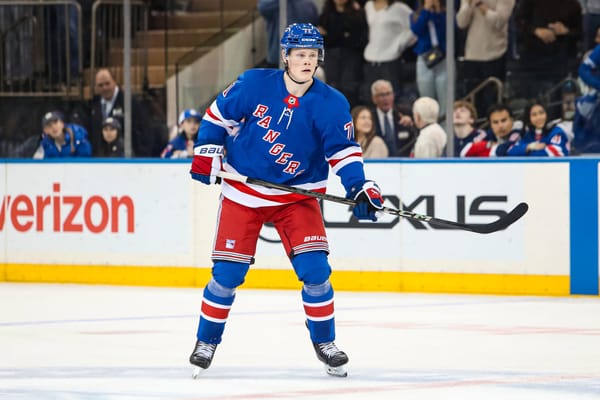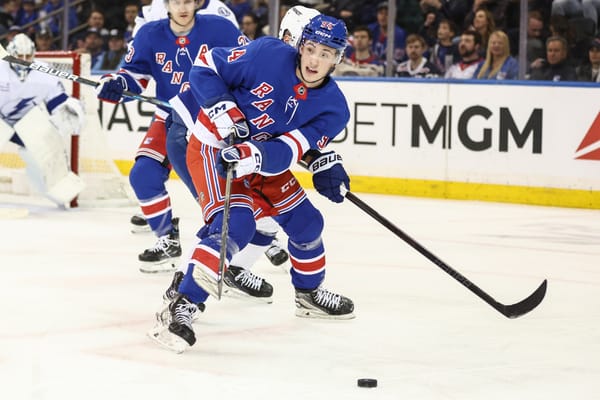Andersson, Lundkvist Score Goals in Head-to-Head Matchup
Lias Andersson’s HV71 and Nils Lundkvist’s Lulea faced off yesterday in the Swedish Hockey League, each scoring in HV71’s 2-1 victory.
Lias Andersson opened the scoring on the power play. He traded passes with Linus Sandin before firing a great wrist shot from the left circle.
SMACK! 💥 Lias Andersson smäller upp den i nättaket. @HV71 #twittpuck #SHL pic.twitter.com/Sx3faX9hfF
— C More Sport (@cmoresport) March 10, 2020
Andersson was second among HV71 forwards with 17 minutes of icetime, and he had a game that’s become typical for him outside the NHL level. He shows just enough to establish his potential to play in the NHL, but also enough to remind you why he isn’t there.
His skating looks better than it did early this year with the Rangers, when Andersson claims he was dealing with foot injuries, but he still clearly lacks separation speed which allows him to pull away from defenders or be first to pucks. His quality wrist shot was on display, but it’s a power play on European ice. Can he create his own shot? Can he move into shooting positions and receive the puck in tight spaces?
His numbers are equally confounding. With the goal, Andersson now has seven, plus five assists, In 14 SHL games this season. The sample is somewhat small, but those are strong numbers for a 21-year-old in the SHL. In fact, by points-per-game, Andersson ranks among the best over the last decade. Please note that I excluded Matt Duchene, who was playing in Sweden temporarily during the 2012-2013 lockout.
Silfverberg aside (who is well above the pack anyway), this isn’t exactly a list of All-Stars. The chances of Andersson living up to his draft status is extremely low, fine. But he’s still producing on par with, or even better than, some quality NHLers. Calle Jarnkrok? Mattias Janmark? Those guys are excellent bottom-six centers. The Rangers would sure love for Andersson to stay and follow that kind of career trajectory.
The underlying numbers are not nearly as flattering. Andersson’s Shot Attempts Percentage is 46.8%, meaning that his team has been out-attempted 133-to-117 when he’s on the ice at five-on-five. That is the third-worst percentage among forwards on HV71, and the team on the whole is at 49.7%.
Andersson is also riding an unsustainable wave of scoring. HV71 are shooting 13.3% with Andersson on the ice at five-on-five, which partially accounts for the high point production. Among his seven goals, four have been on the power play. As mentioned earlier, the question of whether he can create offense at even strength is still unanswered at best.
Nils Lundkvist, drafted in the first round in 2018, added to his breakout season with a goal in the final seconds of the contest.
Nils Lundkvist rifles a one-timer for his 10th goal of the season. #NYR pic.twitter.com/zWKDhSoJxw
— Alex Nunn (@aj_ranger) March 10, 2020
The goal was Lundkvist’s 10th of the year and 30th point in 44 games; fantastic numbers for any teenager in the SHL, let alone a defenseman. A lot of attention has been given to the fact that Lundkvist is the all-time point producer in the SHL/SEL for under-20 defensemen in a single season. As it should. It’s a massive accomplishment. But I do want to put that into context. A lot of the best Swedish defensemen in the past few decades spent their Draft +2 seasons in North America. Here is a select, arbitrary sample of some examples.
That’s not to say that no decent NHL defensemen have played in the SHL as a 19-year-old. In fact, quite a few good ones have who didn’t play a key role for their teams or produce quite like Lundkvist has. Oscar Klefbom, Anton Stralman, and Toby Enstrom are just a few examples of good NHL defensemen whom Lundkvist has significantly outproduced.
The goal came in relative garbage time, but Lundkvist was having a strong showing otherwise. His skating has evidently improved, and in particular he’s moving quicker with the puck. One aspect of his game that I was pleased to see improved was his strength.
Lundkvist ended up reversing the puck to the opposition, which obviously isn’t great, but what I wanted to focus on is the play below the goal line. Lundkvist did an excellent job of establishing favorable position and then not only absorbing contact but actively dishing it out himself. This is the type of play that a year or two ago he may not have come away with the puck so cleanly. He’s not only physically stronger, but learning how to prepare for contact and put himself in the position of leverage.
The Rangers would be justified in signing Lundkvist this summer and bringing him over to North America; perhaps with the chance to compete for an NHL spot. This decision, at least from the Rangers’ side, is more nuanced than a binary “yes” or “no” debate of whether he’s ready. Salary cap implications and what the team does with its roster will dictate what the team wishes to do. It may be more prudent to let him play another season as a top-pairing defenseman for a top SHL team, ensure he’s not rushed, and delay the start of his entry-level contract.
Regardless, the Rangers have to be feel awfully good about Lundkvist’s development this season. Joey Keane’s trade to Carolina was largely inspired by what Adam Fox and Tony DeAngelo were doing at the NHl level, but Lundkvist undoubtedlly played a part in it as well. Nothing is ever guaranteed when talking about teenage prospects, but everything about Lundkvist is pointing towards a long career in the NHL, with the optimistic but hardly unfair expectation that he will be a bonafide, two-way top-four defenseman in the mold of the previoiusly mentioned Stralman or Enstrom.




